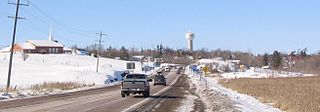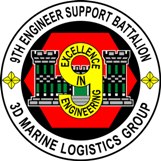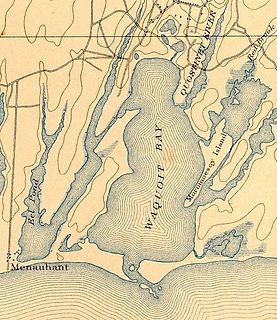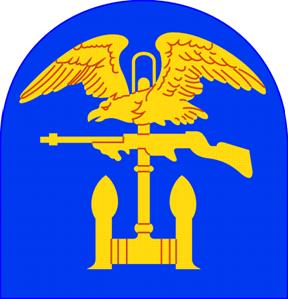
Livermore is a town in Androscoggin County, Maine, United States. Formerly in Oxford County, Maine. The population was 2,095 at the 2010 United States Census. It is included in both the Lewiston-Auburn, Maine Metropolitan Statistical Area and the Lewiston-Auburn, Maine Metropolitan New England City and Town Area. High schools students from Livermore attend Spruce Mountain High School in neighboring Livermore Falls. Livermore is known for The Norlands, the Washburn family home.

Fort Devens is an inactive United States Army military installation in the towns of Ayer and Shirley, in Middlesex County and Harvard in Worcester County in the U.S. state of Massachusetts. It was named after jurist and Civil War general Charles Devens. The nearby Devens Reserve Forces Training Area is located in Lancaster. Although closed in 1996, the fort was reopened the next day as the Devens Reserve Forces Training Area. The name reverted to Fort Devens in May 2007.

The 3rd Marine Division is an infantry division of the United States Marine Corps based at Camp Courtney, Marine Corps Base Camp Smedley D. Butler and Okinawa, Japan. It is one of three active duty divisions in the Marine Corps and together with the 1st Marine Aircraft Wing (1stMAW) and the 3rd Marine Logistics Group forms the III Marine Expeditionary Force. The division was first formed during World War II and saw four years of continuous combat in the Vietnam War.

The Borneo campaign of 1945 was the last major Allied campaign in the South West Pacific Area during World War II to liberate Japanese-held British Borneo and Dutch Borneo. Designated collectively as Operation Oboe, a series of amphibious assaults between 1 May and 21 July were conducted by the Australian I Corps, under Lieutenant-General Leslie Morshead, against Imperial Japanese forces who had been occupying the island since late 1941 – early 1942. The main Japanese formation on the island was the Thirty-Seventh Army under Lieutenant-General Masao Baba, while the naval garrison was commanded by Vice-Admiral Michiaki Kamada. The Australian ground forces were supported by US and other Allied air and naval forces, with the US providing the bulk of the shipping and logistic support necessary to conduct the operation. The campaign was initially planned to involve six stages, but eventually landings were undertaken at four locations: Tarakan, Labuan, North Borneo and Balikpapan. Guerilla operations were also carried out by Dayak tribesmen and small numbers of Allied personnel in the interior of the island. While major combat operations were concluded by mid-July, mopping-up operations continued throughout Borneo until the end of the war in August. Initially intended to secure vital airfields and port facilities to support future operations, preparatory bombardment resulted in heavy damage to the island's infrastructure, including its oil production facilities. As a result, the strategic benefits the Allies gained from the campaign were negligible.

Cobden is a small community in the Township of Whitewater Region, in Renfrew County, Ontario, Canada. It is located roughly halfway between Renfrew and Pembroke on Highway 17.

The 9th Engineer Support Battalion is a general and direct engineering support unit of the United States Marine Corps and is headquartered at Camp Hansen, Okinawa, Japan. The unit is subordinate to the 3rd Marine Logistics Group and the III Marine Expeditionary Force.

2nd Combat Engineer Battalion is a combat engineer battalion of the United States Marine Corps. They are based out of Marine Corps Base Camp Lejeune, North Carolina and fall under the command of the 2nd Marine Division and the II Marine Expeditionary Force.

USS Washburn (AKA-108) was a Tolland-class attack cargo ship of the United States Navy, named after Washburn County, Wisconsin. She was designed to carry military cargo and landing craft, and to use the latter to land weapons, supplies, and Marines on enemy shores during amphibious operations. She served as a commissioned ship for 24 years and 11 months. A large scale model of the ship is in the U.S. Navy Museum in Washington, DC.

Waquoit Bay is a public national estuary, which is typically used as a research reserve. It is a part of Nantucket Sound and is located on the southern shore of Cape Cod in Massachusetts, USA. This bay forms the border of the towns of Falmouth and Mashpee, Massachusetts.

The Ray Norbut State Fish and Wildlife Area is a 1,140-acre (460 ha) state park located near Griggsville in Pike County, Illinois. It borders on the Illinois River and is primarily made of steeply sloped bluffland that is part of the river's valley. Heavily wooded, this region is managed for whitetail deer hunting. The Ray Norbut complex also includes Big Blue Island, a 100-acre (40 ha) riparian island in the Illinois River. The park is managed by the Illinois Department of Natural Resources (IDNR).

The Battle of Morotai, part of the Pacific War, began on 15 September 1944, and continued until the end of the war in August 1945. The fighting started when United States and Australian forces landed on the southwest corner of Morotai, a small island in the Netherlands East Indies (NEI), which the Allies needed as a base to support the liberation of the Philippines later that year. The invading forces greatly outnumbered the island's Japanese defenders and secured their objectives in two weeks. Japanese reinforcements landed on the island between September and November, but lacked the supplies needed to effectively attack the Allied defensive perimeter. Intermittent fighting continued until the end of the war, with the Japanese troops suffering heavy loss of life from disease and starvation.

Camp Edwards is a United States military training installation which is located in western Barnstable County, Massachusetts. It forms the largest part of Joint Base Cape Cod, which also includes Otis Air National Guard Base and Coast Guard Air Station Cape Cod. It was named after Major General Clarence Edwards. It is home to the 3rd Battalion, 126th Aviation.
Camp Candoit, also known as Camp Cotuit was a satellite camp of Camp Edwards. It was located in Cotuit, Massachusetts.
Camp Havedonit was a satellite camp of Camp Edwards. It was located in Osterville, Massachusetts.

Engineer Special Brigades were amphibious forces of the United States Army developed during World War II. Initially designated engineer amphibian brigades, they were redesignated engineer special brigades in 1943. The 1st, 5th, and 6th Engineer Special Brigades were assigned to the European Theater of Operations. The 1st Engineer Special Brigade participated in the landings in Sicily and Italy before joining the 5th and 6th Engineer Special Brigades for the invasion of Normandy.

Minami Torishima Airbase is a one runway airport serving the island of Minami Torishima, Japan. The aerodrome used to be a military airstrip and according to the Japanese Aeronautical Information Service, is still operated by the Japan Maritime Self-Defense Force.

Gablingen Kaserne is a former military facility in Gablingen near Augsburg, Germany, which was closed in 1998. Its primary use was signals intelligence collection during the Cold War.

Androscoggin Lake is a body of water located in the towns of Wayne and Leeds, Maine. The surface area of the lake is 3,826 acres (1,548 ha). Its greatest length is 4.5 mi (7.2 km) and its greatest width is 2.8 mi (4.5 km). The lake is very shallow with a mean depth of 15 ft (4.6 m) and maximum depth of 38 ft (12 m). The lake temperature is therefore quite warm during summer, and the temperature is the same on the bottom as it is on the top, making it a homothermous body of water. There are 4 islands on the lake: Androscoggin Island, Blodgett Island, Lothrop Island and Norris Island. The islands support a diverse assemblage of rare species and natural communities. The most extensive areas are along and around the Dead River,(photo) which connects the lake to the Androscoggin River. The islands also provide important nesting habitat for bald eagles, ospreys and great blue herons. Lothrop Island's black sand beaches are of geological interest and are also home to several rare plants.

MCAS Vieques Airport was a Marine Corps Air Station (MCAS) at MCB Camp Garcia on the island of Vieques, Puerto RicoVieques, Puerto Rico. It was built in 1960 by USMC engineers and consisted of a single 5,000 ft east–west runway. It was used to fly in troops, equipment and supplies to support amphibious landing training missions.


















